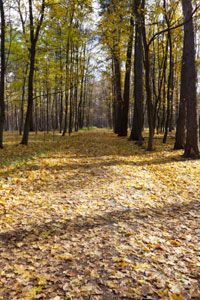The Harmful Earthworm?
Sure, they decompose organic matter, break it into usable nutrients for their local ecosystems and recycle compost. But as helpful as they are, researchers have recently come to see the earthworm in another way: as destructor.
The very same traits that make them beneficial can also make earthworms harmful. Study after study finds that earthworms are voracious eaters: One found they can break down about 90 percent of the surface leaf litter in an apple orchard in a single winter; another estimated that earthworms can consume about 9,240 pounds (4,200 kilograms) of organic litter for every 2.47 acres in 11 weeks [sources: Werner, Werner and Bugg]. But that same leaf litter that earthworms eat so efficiently is also the habitat for spiders, lizards, beetles and other arthropods, frogs, snails and innumerable other species. Put simply, earthworms eat these other animals and plants out of house and home.
Advertisement
The litter horizon also serves as protection for seeds that grow to form the understory plant community of a forest -- all the smaller plants and saplings that make up the lower canopy of vegetation near ground level. Studies have found earthworm activity can reduce both the total coverage and the diversity of plant species among the understory canopy by between 25 and 75 percent [source: University of Minnesota]. This effect ripples up the food chain to affect deer and other vertebrates that depend on that vegetation for food.
There is also evidence that earthworms also have a counterproductive effect on carbon sequestration. One of the major roles of soil is to act as a sink for storing carbon and prevent a disproportionate release into the atmosphere. That organic material earthworms eat have carbon locked up inside, in addition to nitrogen; worms unlock this carbon by breaking down the organic matter, and can contribute to as much as an additional 28 percent of carbon released from the soil by researchers from Colgate University's estimate [source: Kinver].
In North America, all of this is in line with the fact that, despite the many benefits of their presence, most earthworms are non-native, invasive species. The loss of earthworm species during the last ice age left northern woodlands to successfully adapt to conditions without them. With the reintroduction of earthworms to these ecosystems in the last few hundred years, the effects have been the same as with the introduction of any other invasive species: What was once the "natural" order is changing, as ecosystems evolve once again to adapt, this time to the presence, not the absence, of earthworms.
Earthworm FAQ
How long can earthworms grow?
What do earthworms eat?
Are earthworms dangerous?
Do earthworms have eyes?
Why are earthworms bad?
Related Articles
More Great Links
Sources
- Backman, Paul. "Earthworm casting creates maintenance nightmare." Grounds Maintenance. July 1, 1999. http://www.wormdigest.org/content/view/112/2/
- Barrett, Thomas J. "Harnessing the Earthworm." Bruce Humphries: Boston, 1947. http://www.herper.com/earthworms/earthworms-breeding-habits.html
- Bugg, Robert L. "Earthworm update." Sustainable Agriculture/Technical Reviews. 1994. http://www.sarep.ucdavis.edu/worms/update.htm
- Conrad, Jim. "Earthworms." The Backyard Nature Website. May 17, 2010. http://www.backyardnature.net/earthwrm.htm
- Darwin, C.R. "The formation of vegetable mould, through the action of worms, with oberservations on their habits." London: John Murray. 1881. http://darwin-online.org.uk/content/frameset?itemID=F1357&viewtype=side&pageseq=1
- Discovery Kids. "Worm world: Eddie earthworm." Accessed Sept. 12, 2011. http://yucky.discovery.com/flash/worm/pg000216.html
- University of Illinois Extension Service. "Worm facts." Urban Programs Resource Network. Accessed Sept. 12, 2011. http://urbanext.illinois.edu/worms/facts/index.html
- Earthworm Society of Britain. "Earthworm diversity." Accessed November 27, 2011. http://www.earthwormsoc.org.uk/earthworm-information/earthworm-diversity1
- Edwards, Clive Arthur. "Earthworm ecology." CRC Press 2004. http://books.google.com/books?id=7mHvxY-1BKsC&pg=PA409&lpg=PA409&dq=preferred+conditions+earthworms&source=bl&ots=FKdQMKH34M&sig=nP1PcaJo494wrCSew3y9Spy08OQ&hl=en&ei=7aHTTtjcBOLq0gGJ_YjNBg&sa=X&oi=book_result&ct=result&resnum=8&ved=0CFYQ6AEwBw#v=onepage&q=preferred%20conditions%20earthworms&f=false
- Edwards, Clive A. "The Soil Biology Primer: Chapter 8: earthworms." Ohio State University. Accessed Sept. 12, 2011. http://soils.usda.gov/sqi/concepts/soil_biology/earthworms.html
- Gersper, et al. "Cuban agriculture looks to vermiculture." The Cultivar. Summer 1993. http://www.fadr.msu.ru/rodale/agsieve/txt/vol7/art1.html
- Great Lakes Worm Watch. "Forest ecology and worms: plants." University of Minnesota. Accessed Nov. 28, 2011. http://www.nrri.umn.edu/worms/forest/plants_herb.html
- Great Lakes Worm Watch. "Worm identification: earthworm ecological groups." University of Minnesota. Accessed Nov. 28, 2011. http://www.nrri.umn.edu/worms/identification/ecology_groups.html
- Green-Pik. "Worms, humus, harvest." Accessed Nov. 27, 2011. http://www.green-pik.eu/en/knowledgebase/21-vihmaussid-huumus-saak
- Holdsworth, Andy, et al. "Invasive earthworms." Minnesota Department of Natural Resources. March 2003. http://www.dnr.state.mn.us/invasives/terrestrialanimals/earthworms/index.htmls
- Kinver, Mark. "Alien worm invasion 'threat to forests'." Sept. 6, 2011. http://www.bbc.co.uk/news/science-environment-14788783
- Lenet, Ryan. "Earthworms." University of Pennsylvania. Accessed Sept. 12, 2011. http://www.sas.upenn.edu/~rlenet/Earthworms.html
- Martin, J.P., Black, J.H., and Hawthorne, R. M. "Earthworm biology." Florida Cooperative Extension Service. June 2005. http://edis.ifas.ufl.edu/pdffiles/IN/IN04700.pdf
- Muratake, Satoko. "Effects of exotic earthworms on Northern hardwood forests in North America." Restoration and Reclamation Review. Fall 2003. http://conservancy.umn.edu/bitstream/60216/1/8.1.Muratake.pdf
- Raskoff, Kevin A., PhD. "6: Annelid." Monterrey Peninsula College. Accessed Nov. 25, 2011. http://www.mpcfaculty.net/kevin_raskoff/classes/biology22/6Annelid.pdf
- Samuels, Sam Hooper. "Alien earthworms' offspring thrive, and alter, US soil." New York Times. Aug. 29, 2000. http://partners.nytimes.com/library/national/science/082900sci-animal-worm.html
- Southwest Wildlife. "Aestivation." 2007. http://www.southwestwildlife.org/pdf/Selected_topics/aestivationr.pdf
- Tomlin, Alan C. "Earthworm biology." Worm Digest. Feb. 19, 2006. http://www.wormdigest.org/content/view/200/2/
- Turpin, Tom. "On six legs: Springtime flies are parasites of earthworms." Purdue University Extension Service. April 23, 2009. http://www.agriculture.purdue.edu/agcomm/newscolumns/archives/OSL/2009/April/090423OSL.html
- Washington State University. "Composting with redworms." Accessed Nov. 28, 2011. http://whatcom.wsu.edu/ag/compost/redwormsedit.htm
- Werner, Matthew and Bugg, Robert. "Earthworms: renewers of agroecosystems." Sustainable Agriculture. Fall 1990. http://www.sarep.ucdavis.edu/NEWSLTR/v3n1/sa-9.htm
- Werner, Matthew R. "Earthworm ecology and sustaining agriculture." Components. Fall 1990. http://www.sarep.ucdavis.edu/worms/werner.htm
- Wormman.com. Redworms for composting or for feeding pets." Accessed Nov. 25, 2011. http://www.wormman.com/pd_red.cfm
